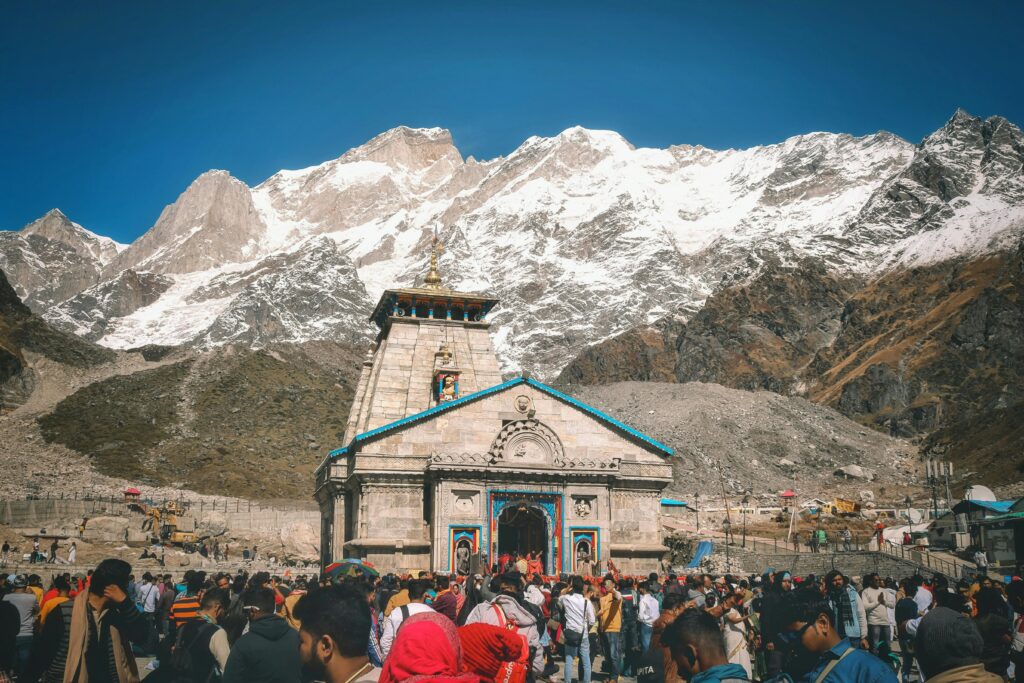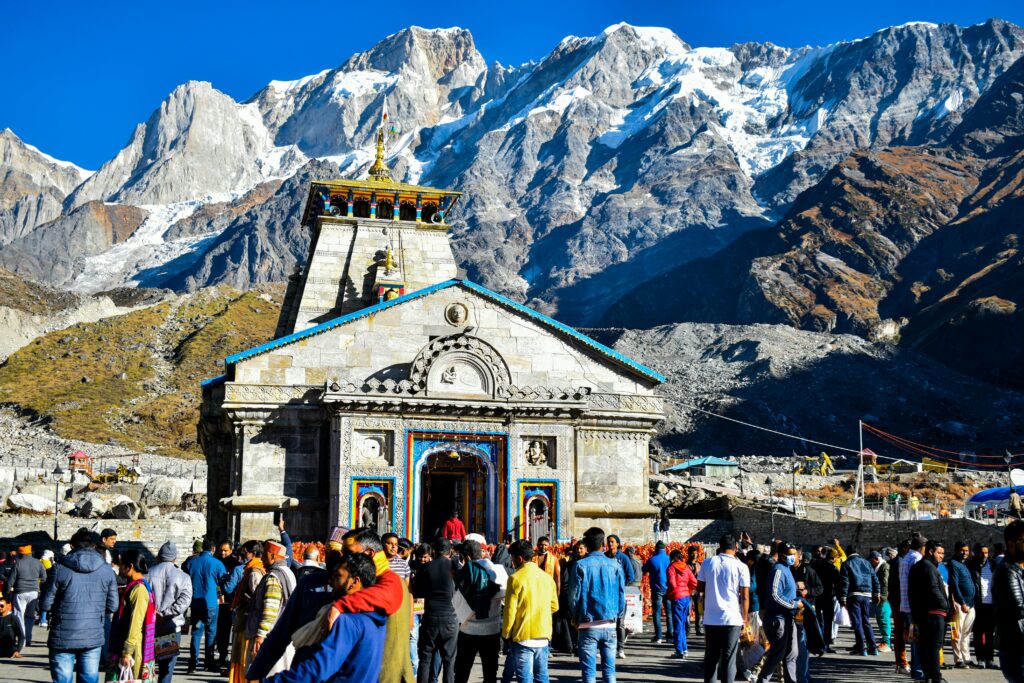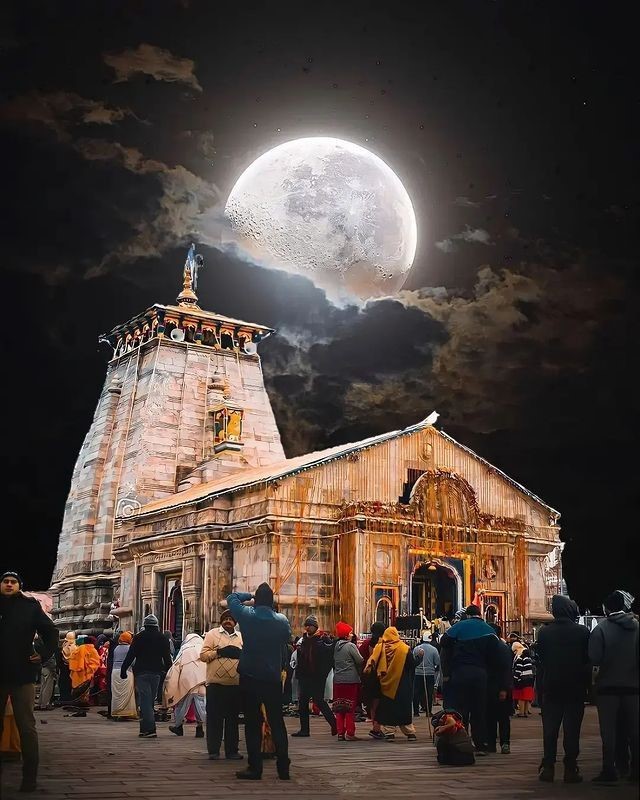
Kedarnath Temple
History of Kedarnath
Kedarnath, located in the Garhwal Himalayas in Uttarakhand, India, is one of the most revered pilgrimage sites in India. It holds significant spiritual importance for Hindus as it is dedicated to Lord Shiva. The history of Kedarnath is deeply intertwined with ancient myths, religious practices, and its connection to the Pandavas, the legendary characters from the Indian epic Mahabharata.
-
- Ancient Mythological Roots
Kedarnath’s history is primarily rooted in Hindu mythology. It is believed that after the great battle of Kurukshetra, the Pandavas, seeking redemption for the sins committed during the war, came to Kedarnath to seek the blessings of Lord Shiva. The legend says that Lord Shiva, in the form of a bull, hid himself in the Garhwal region to avoid being confronted by the Pandavas. However, the Pandavas managed to track him down and worshipped him at this holy site. The Shivling in the Kedarnath Temple is said to represent Lord Shiva in this form.
- Ancient Mythological Roots
-
- Adi Shankaracharya and the Temple’s Establishment
The present-day Kedarnath Temple is believed to have been built by the great philosopher and spiritual leader, Adi Shankaracharya, in the 8th century CE. Adi Shankaracharya is credited with reviving the spiritual importance of Kedarnath by establishing it as a key site in the Char Dham Yatra, a pilgrimage that includes four important sites: Kedarnath, Badrinath, Yamunotri, and Gangotri. It is said that he organized the temple’s structure and sanctified it as one of the twelve Jyotirlingas (divine manifestations of Lord Shiva).
- Adi Shankaracharya and the Temple’s Establishment
-
- Medieval to Modern History
Over the centuries, Kedarnath has been a site of religious reverence and pilgrimage, drawing devotees from across India. The region has witnessed many invasions and natural calamities, but the temple and the surrounding area have remained resilient. The temple’s location, perched at a high altitude of 3,583 meters (11,755 feet) above sea level, made it difficult for invaders to reach, which helped preserve the temple through history.
- Medieval to Modern History
-
- The 2013 Disaster
One of the most significant events in recent history for Kedarnath was the devastating disaster in June 2013, when heavy rainfall led to catastrophic floods and landslides in the region. The Mandakini River, which flows near Kedarnath, overflowed, and massive destruction occurred. Many people were killed, and several parts of the region, including roads and infrastructure, were destroyed. The Kedarnath Temple, however, miraculously survived the disaster. In the aftermath, extensive efforts were made to rebuild the area and restore the temple complex.
- The 2013 Disaster
-
- Reconstruction and Preservation
Post-2013, the Indian government and various organizations focused on reconstructing Kedarnath, improving safety measures, and enhancing the facilities for pilgrims. The region now has improved infrastructure, including better roads and security measures to ensure the safety of pilgrims. The temple was reopened after thorough checks and restoration work was done, and it continues to attract millions of devotees each year.
- Reconstruction and Preservation
-
- Religious and Cultural Importance
Kedarnath remains one of the four major pilgrimage sites in the Char Dham Yatra, which holds immense religious significance in Hinduism. The pilgrimage to Kedarnath is considered sacred, and the temple is revered by devotees for its connection to Lord Shiva. The temple’s unique location and architectural marvel, combined with its mythological importance, make it a central aspect of India’s religious heritage.
- Religious and Cultural Importance
-
- Kedarnath in Modern Times
In recent decades, Kedarnath has become a significant center for both spiritual seekers and trekkers. The region is not only visited for religious reasons but also attracts nature enthusiasts and adventure seekers who come to experience its challenging trekking routes, magnificent views of the Himalayan ranges, and the tranquil atmosphere. The introduction of helicopter services has also made it more accessible to pilgrims who cannot undertake the arduous trek.
- Kedarnath in Modern Times

Kedarnath is a town and Nagar Panchayat in Rudraprayag district of Uttarakhand, India, known primarily for the Kedarnath Temple. It is approximately 86.5 kilometres from Rudraprayag, the district headquarters. Kedarnath is the most remote of the four Chota Char Dham pilgrimage sites. It is located in the Himalayas, about 3,583 m (11,755 ft) above sea level near the Chorabari Glacier, which is the source of the Mandakini River. The town is flanked by snow-capped peaks, most prominently the Kedarnath Mountain. The nearest road head is at Gaurikund about 16 km away. The town suffered extensive destruction during June 2013 from the Flash Floods caused by torrential rains in Uttarakhand state.
One special thing about Kedarnath is the miraculous preservation of the Kedarnath Temple. Despite the devastating 2013 floods that caused widespread destruction in the region, the Kedarnath Temple remained largely untouched. Local legends and beliefs attribute this to the divine protection of Lord Shiva. Many pilgrims view the temple’s survival as a sign of the Lord’s grace and consider it a miraculous occurrence, adding to the temple’s spiritual significance.

Kedarnath Dham, located in the Indian state of Uttarakhand, is one of the holiest pilgrimage sites for Hindus, part of the Char Dham Yatra. Situated in the rugged terrains of the Garhwal Himalayas, it is dedicated to Lord Shiva. The Kedarnath Temple, perched at an altitude of around 3,580 meters (11,750 feet), is renowned for its ancient stone architecture, believed to have been built by the Pandavas and later renovated by Adi Shankaracharya. The trek to Kedarnath is both challenging and awe-inspiring, offering breathtaking views of snow-capped mountains and pristine landscapes. Despite the harsh weather conditions and difficult terrain, pilgrims from across the world visit Kedarnath to seek blessings, making it one of the most revered and spiritually uplifting destinations in India.
The Kedarnath River is a significant water body that flows near the Kedarnath Temple in Uttarakhand, India. It is a tributary of the Mandakini River, which originates from the Chorabari Glacier, located near Kedarnath. Here’s a brief overview of the Kedarnath River:
-
- Source and Flow: The Kedarnath River originates from the Chorabari Glacier, which is situated above Kedarnath at an altitude of about 3,700 meters (12,139 feet). The river flows down through the steep mountainous terrain, making its way to the Mandakini River.
-
- Significance to Pilgrims: The Kedarnath River is sacred to devotees visiting the Kedarnath Temple, as it is considered part of the divine landscape surrounding the shrine. The river adds to the spiritual ambiance of the region, with its clear, cold waters and picturesque surroundings.
-
- Role in the Environment: The river plays a crucial role in the local ecosystem, providing water to the surrounding flora and fauna. Its clear, glacial waters make it a unique feature of the region’s mountainous terrain.
-
- Historical and Cultural Importance: The river, like many in the Himalayas, is believed to be a part of the divine and natural elements that are an essential part of Hindu mythology. Water from the Kedarnath River is sometimes collected by pilgrims for religious and ceremonial purposes.
-
- 2013 Disaster: During the catastrophic floods in 2013, the Kedarnath River swelled dramatically, causing widespread devastation in the region. The river’s force, along with landslides and heavy rains, led to significant loss of life and infrastructure damage. Despite the destruction, the Kedarnath Temple itself was miraculously spared.
Kedarnath is known for its spiritual significance, stunning natural beauty, and the overall experience it offers to visitors. Here are some of the best things about Kedarnath:

1. Kedarnath Temple : The main attraction in Kedarnath is the Kedarnath Temple itself, dedicated to Lord Shiva. The temple, situated at an altitude of 3,583 meters, is a marvel of ancient architecture and holds deep religious importance for Hindus.
2. Scenic Trek : The trek to Kedarnath is one of the most beautiful and spiritually enriching experiences. The route takes you through lush valleys, scenic meadows, dense forests, and magnificent snow-capped peaks, making it a paradise for nature lovers and trekkers.
3. Spiritual Atmosphere : Kedarnath’s serene and peaceful environment is perfect for those seeking spiritual solace. The temple, surrounded by the Himalayas, provides a truly divine experience.
4. Breathtaking Views : The panoramic views of the Himalayan range, including peaks like Kedarnath, Chaukhamba, and other high mountains, make it one of the most picturesque destinations in India.
5.Helicopter Services : For those who are unable to complete the long trek, helicopter services are available from nearby locations like Phata, which provide an aerial view of the majestic Kedarnath Valley.
6.Baba Kedarnath’s Blessings: The atmosphere of the place is filled with spirituality. Devotees believe that praying here gives them the blessings of Lord Shiva and brings peace and fulfillment in their lives.
Nearby Attractions: While Kedarnath itself is a major highlight, nearby places like Gaurikund, the starting point of the Kedarnath trek, and Chopta (also known as the “Mini Switzerland of India”) offer additional scenic beauty and are popular among tourists.

Overall, the best thing about Kedarnath is the unique blend of spirituality, natural beauty, and adventure, making it an unforgettable destination.
Kedarnath, located in Uttarakhand, is a prominent Hindu pilgrimage site. It is an important part of the Char Dham Yatra, attracting thousands of devotees every year. Kedarnath is known for its temple, natural beauty, and historical significance. Here are some additional details about Kedarnath:
-
- Kedarnath Temple
The Kedarnath Temple is dedicated to Lord Shiva and was established by Adi Shankaracharya. It is situated at a high altitude in the Himalayas, making it one of the most significant temples among the Char Dham pilgrimage sites. The temple is surrounded by breathtaking views, and the journey to reach it involves a 16 km trek. Despite the physical challenges, pilgrims find the spiritual experience overwhelming.
- Kedarnath Temple
-
- History and Spiritual Significance
Kedarnath has ancient historical ties. It is believed to be associated with the Mahabharata era. According to legends, the Pandavas sought refuge here and prayed to Lord Shiva. The spiritual importance of Kedarnath has made it a major pilgrimage destination for centuries.
- History and Spiritual Significance
-
- Natural Beauty
Kedarnath is also known for its stunning natural beauty. The landscape is dominated by the Shivalik mountain range, lush greenery, and snow-capped peaks, offering a unique and serene experience. The weather can be harsh, especially in winter, but the views of the surrounding nature are unparalleled.
- Natural Beauty
-
- Trekking and Journey
The journey to Kedarnath starts from Gaurikund, where a 16 km trekking route leads to the temple. The trek is quite challenging, but the journey offers beautiful views of the mountains and valleys. For those who find trekking difficult, helicopter services are also available to reach Kedarnath.
- Trekking and Journey
-
- The Temple’s Architecture and Grandeur
The Kedarnath Temple is a fine example of ancient stone architecture. Inside the temple, a Shivling is enshrined. The temple complex has smaller structures and religious displays that make it even more intriguing for visitors. The temple’s grandeur and architecture make it a unique spiritual site.
- The Temple’s Architecture and Grandeur
-
- Best Time to Visit
The best time to visit Kedarnath is between April and November, when the weather is more accessible for pilgrims. From December to March, the area is often covered in snow, making it difficult to travel. The temple sees heavy pilgrim traffic during festivals like Navratri, Maha Shivaratri, and the Char Dham Yatra.
- Best Time to Visit
-
- Disaster and Reconstruction
In 2013, Kedarnath was severely affected by a massive flood and landslides, which resulted in many casualties and significant damage to the region. However, the area has since been reconstructed and restored to its former glory. Today, it remains a vital spiritual destination for people from all over the world.
- Disaster and Reconstruction
Kedarnath is not only a place of religious significance but also offers a profound experience of natural beauty and history, attracting pilgrims and nature enthusiasts alike.

Kedarnath is a truly remarkable place, famous not only for its spiritual significance but also for its natural beauty and unique charm. Here are some more details and the beauty of Kedarnath:
-
- Spiritual and Peaceful Atmosphere
Kedarnath is a serene and peaceful place. The temple is located at a high altitude in the Himalayas, surrounded by snow-covered peaks, lush greenery, and breathtaking landscapes. The atmosphere here is tranquil, making it an ideal place for meditation and spiritual reflection. The purity of the surroundings adds to the spiritual experience, making it a deeply peaceful destination.
- Spiritual and Peaceful Atmosphere
-
- Majestic Views of the Himalayas
The scenic beauty of Kedarnath is unmatched. The towering snow-capped peaks of the Himalayas surround the temple, and the crisp mountain air fills the atmosphere. The mountains, especially Kedarnath Peak, offer a majestic backdrop, making it one of the most stunning places in India. The panoramic views of the valleys and the flowing rivers add to the serenity of the region.
- Majestic Views of the Himalayas
-
- Sacred River Mandakini
The Mandakini River, which flows near the Kedarnath Temple, is considered sacred. It originates from the Chorabari Glacier, which is located above the temple. The river adds to the beauty of the area, with its crystal-clear water flowing through the rocky terrain. The sight of the Mandakini River, combined with the surrounding mountains, is a memorable experience for any visitor.
- Sacred River Mandakini
-
- Wildlife and Flora
Kedarnath is also known for its unique wildlife and diverse flora. The region is home to several species of birds, animals, and plants. While trekking, visitors can spot Himalayan animals like the Himalayan Monal (state bird of Uttarakhand) and other wildlife species. The region also has a variety of medicinal plants and high-altitude flowers, adding to the area’s ecological charm.
- Wildlife and Flora
-
- Spiritual Significance of the Temple
The Kedarnath Temple is one of the twelve Jyotirlingas of Lord Shiva and holds immense religious importance. The temple’s location amidst the majestic Himalayas gives it a divine aura, and its ancient structure, carved with intricate designs, is a testament to its long history. The temple’s presence in such a pristine location adds to the spirituality and holiness of the place.
- Spiritual Significance of the Temple
-
- Weather and Seasons
Kedarnath’s weather varies dramatically with the seasons, adding to its appeal. In the summer (May to June), the weather is cool and pleasant, making it the perfect time for trekking and exploring. In the monsoon (July to September), heavy rains can make travel difficult, and the winters (October to March) are extremely cold, with snow covering the region. The snow-covered landscape in winter is also a sight to behold.
- Weather and Seasons
-
- A Unique Spiritual Experience
One of the most remarkable aspects of Kedarnath is the deep spiritual experience that it offers. The journey to the temple, the trekking route, and the view of the temple against the backdrop of the majestic mountains, all contribute to a feeling of awe and connection to something divine. Many people visit Kedarnath for spiritual awakening, seeking peace and solace in this sacred space.
- A Unique Spiritual Experience
-
- Cultural Heritage
Kedarnath is rich in cultural heritage and has a deep connection with the traditions of Hinduism. It is not just a place of worship but also an important cultural landmark. The region’s festivals, rituals, and local customs make it an interesting place for those who want to experience the cultural side of the Himalayan region.
- Cultural Heritage
In summary, Kedarnath is a place where spirituality, natural beauty, and adventure come together. The combination of its serene environment, majestic mountains, sacred rivers, and rich cultural significance makes it a must-visit destination for pilgrims, trekkers, and nature lovers alike.
